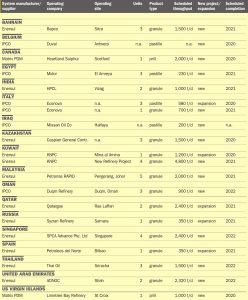
Sulphur forming project listing 2021
Sulphur ’s annual listing of new or recently completed sulphur forming projects worldwide covers both new sour gas and refinery sulphur forming projects as well as upgrades at existing units.

Sulphur ’s annual listing of new or recently completed sulphur forming projects worldwide covers both new sour gas and refinery sulphur forming projects as well as upgrades at existing units.
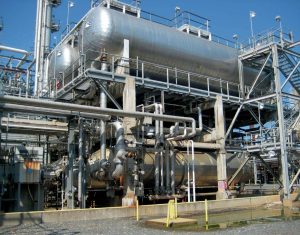
The continuing spread of alkylation technology and the preference for the sulphuric acid route are leading to increased demand for acid in refineries.
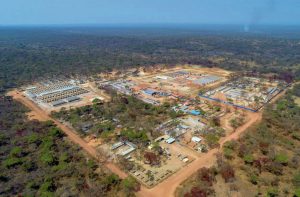
Production has begun at Ivanhoe Mines’ Kakula copper mine in the DRC. The company says that total production for this year is expected to be 80-95,000 t/a of copper in concentrate, with a phase two expansion to 400,000 t/a due to be completed by Q2 2022. Ivanhoe is working with China’s Zijin Mining on the development plan for phases 2 and 3 of the mine, as well as a feasibility study for the Kipushi zinc mine further to the east. Both projects lie close to the DRC’s southern border, with Angola and Zambia respectively. Phase 3 of Kamoa will lift capacity to an anticipated 600-800,000 t/a of copper in concentrate, making it the second largest copper mine in the world after Escondida in Chile. Canadian-based Ivanhoe expects to be digging 3.8 million t/a of ore at Kakula with 6% copper content in Phase 1.
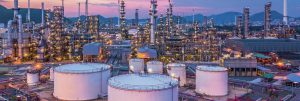
With demand for conventional fuels projected to peak and fall over the next decade, some refiners are looking to petrochemical production as a way of diversifying their product slate.
Tecnimont has been awarded a $1.5 billion contract by Nigeria’s Federal Executive Council to carry out rehabilitation works at the Port Harcourt refinery in Rivers State, run by the state-owned Nigerian National Petroleum Company (NNPC). The contract covers engineering, procurement and construction (EPC) activities for a full rehabilitation of the Port Harcourt refinery complex, aimed at restoring the complex to a minimum of 90% of its 210,000 bbl/d nameplate capacity. Tecnimont says that the project will be delivered in phases from 24 and 32 months and the final stage will be completed in 44 months from the award date.
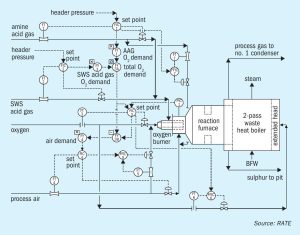
With the sulphur content of crude oil and natural gas on the increase and with the ever-tightening sulphur content in fuels, refiners and gas processors will require additional sulphur recovery capacity. At the same time, environmental regulatory agencies of many countries continue to promulgate more stringent standards for sulphur emissions from oil, gas and chemical processing facilities. Rameshni & Associates Technology and Engineering discusses options for compliance with new regulations on emissions regarding IMO 2020 compliance and report on the results and evaluation of three case studies. Worley Comprimo reports on the revamp of a sulphur complex built in the late 1980s at a refinery in East Asia with the aim to increase the capacity, improve the availability and reliability and make the unit environmental compliant.
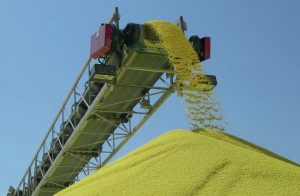
While the covid pandemic has kept refinery run rates down in 2020, new refinery sulphur capacity will nevertheless form the bulk of new additions to sulphur production over the next few years. But delays to projects on both the supply and demand sides could tip a fairly balanced market in either direction.
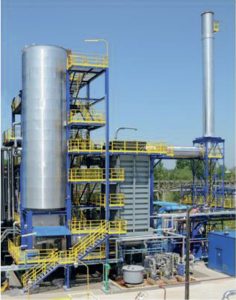
Wet sulphuric acid technology when used as tail gas treatment for a Claus unit, or in place of a Claus unit with amine-based tail gas unit, brings many benefits if there is a market for the sulphuric acid and steam. A new alternative is to have a WSA unit in combination with a Claus unit and to recycle the acid to the Claus unit for higher sulphur recovery efficiency.
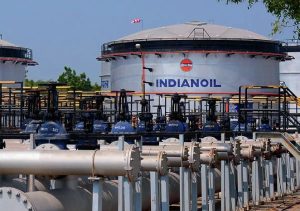
Storm Uri which blanketed the southern states of the US with snow, and led to widespread power outages in Texas, has had a major impact upon US Gulf Coast and Southern-Midwest refined products supply. Most Gulf Coast refineries were shut down or forced to operate at reduced rates. IHS Markit estimated that more than 5.2 million bbl/d of Gulf Coast capacity and 730,000 bbl/d in PADD 2 was impacted by the winter weather at its height, and close to 20% of lower 48 US natural gas production was shut-in in the first half of February. A drop in crude oil production of between 2.2 and 4 million bbl/d was estimated.

NOx emissions from chemical processes such as steam methane reforming contribute to air pollution. The chemical industry is required to take steps to lower such emissions. Technology, developed for related industries, can be designed and optimised to reduce NOx emissions from steam methane reformers. Emission control experts can use a combination of modelling and experience to guide plant operators in recommending and designing optimum, sometimes tailor-made solutions. In this article different options are discussed including low NOx burners, selective catalytic reduction, selective non-catalytic reduction and high emissivity ceramic coatings.